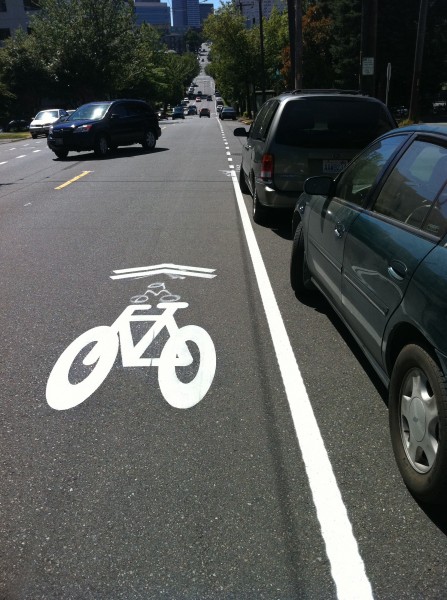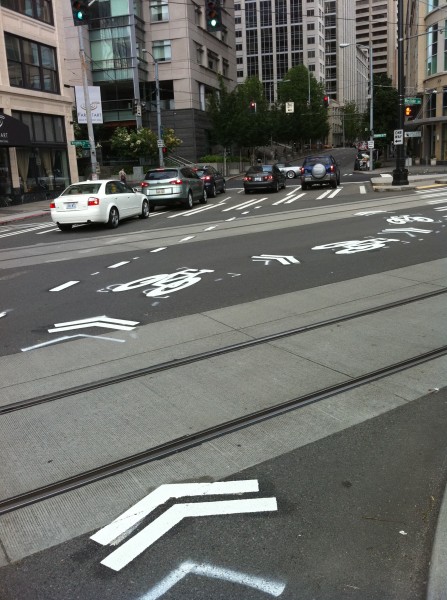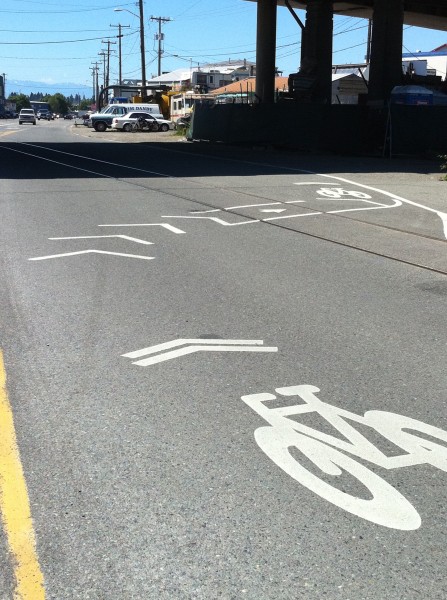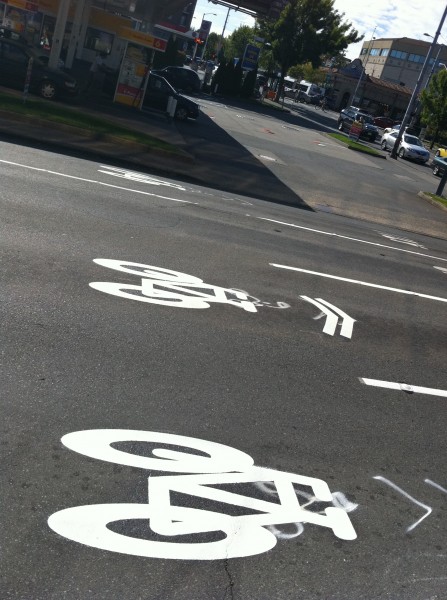 They’re non-controversial, but also kind of useless. They’re not going to get many new people on their bikes, but they’re better than nothing (right?). I’m talking, of course, about the sharrow.
They’re non-controversial, but also kind of useless. They’re not going to get many new people on their bikes, but they’re better than nothing (right?). I’m talking, of course, about the sharrow.
During Mia Birk’s recent visit to Seattle, she has focused much of her attention on our city’s use of the sharrow. She was very skeptical at first. After all, she lead much of Portland’s bike infrastructure efforts, which have been successful in getting new people on their bikes by providing high quality, often separated bike facilities.
And let’s be honest, the sharrow is often nothing more than bike riders marking our territory. It’s like a city-sanctioned tag. They don’t provide bike riders with any more privileges or rights than we have on other streets, rather they are just visual reminders that those privileges also exist on this street.
Seattle Likes Bikes published a post a year ago that dives into the differences between “proper” sharrow usage (as outlined in the MUTCD) and what Seattle does. In Seattle, the sharrows are often used as a guide to suggest (though it is not law) to riders where on the roadway they should ride. I can see some value in this role, since it is too often that I see people timidly riding much too far to the right of the roadway or right next to parked car doors. If the sharrow gives riders the encouragement to ride in a safer position (and give them the confidence to assert their legal right to be there), then that is a good thing. After all, experienced riders will simply assert their rights and ride where they know is safest, regardless of road markings.
However, the worst thing a sharrow can do is tell bike riders to stay dangerously close to parked cars or other hazards. This is not uncommon in Seattle, especially with older markings (the “bike in a house” markings, which are an old sharrow design, are rarely placed properly).
The other problem with sharrows is that they give a political out for half-assing a road project that needs bike infrastructure. Bike lanes (especially protected or buffered lanes) often require a reduction in either parking or general traffic lanes. By painting sharrows on the road, the city can avoid a fight and still chalk that road up as having a “bicycle facility.”
So, in which situations should sharrows be used? After visiting Seattle recently, Birk came up with the following on her blog:
1. Gap closure on a road that has bike lanes, bike boulevards, or off-street paths on either end. It’s tricky to state a maximum gap closure distance, but I’d say a half mile is reasonable. Could be longer depending on the circumstances.
2. On neighborhood greenways/bike boulevards as both guidance on where you want cyclists to ride and as passive identification/marketing. See the Streetfilm’s Bike Boulevards Video, and the PBOT Plan on Greenways for more information. Note that design of a neighborhood greenway/bike boulevard is intended to create a safe, comfortable shared use environment.
3. On a downhill in combination with an uphill bike lane…
4. Streets where cyclists can keep up with traffic, such as on downtown Portland’s one-way streets where traffic signals are timed at 12 to 15 mph and cyclists can easily keep up.
Seattle has also used them with some success as a Band-Aid for particularly dangerous sections of road, such as near the trolley tracks on Westlake:
 and the Burke-Gilman Missing Link:
and the Burke-Gilman Missing Link:
 Clearly, these situations are not ideal. However, they are about as good of Band-Aids as you could really do, I guess.
Clearly, these situations are not ideal. However, they are about as good of Band-Aids as you could really do, I guess.
The city has also used them at intersections to mark which lanes bikes should use or — as in the case of the photo below at 11th NE and NE 45th — should not use:
 What other sharrow uses have you seen? What’s good, and what’s bad?
What other sharrow uses have you seen? What’s good, and what’s bad?








Comments
11 responses to “Poisoned Sharrow”
My favorite type of badly placed sharrow marker is where the double arrow actually points directly into a sinkhole or some other hazard.
The best study I’ve seen on sharrows was done in San Francisco. The verdict: They work.
http://www.sfmta.com/cms/uploadedfiles/dpt/bike/Bike_Plan/Shared%20Lane%20Marking%20Full%20Report-052404.pdf
Obviously sharrows shouldn’t be used when a full bike lane is doable, and they shouldn’t be an excuse to not add additional facilities, but overall, I think we should applaud SDOT’s embrace of a proven piece of bike infrastructure.
Mike, Mia (quoted in the article above) was the project manager for the consultant team (Alta Planning) that conducted the San Francisco study and wrote the report to which you’ve linked.
The sharrows report is now over five years old (and was written before there was much evidence – anecdotal or otherwise – as to the effectiveness of sharrows). It’s worth considering the author’s (re)visiting of the relative merit and appropriateness of sharrows in different situations now that there’s more data, information, and experience with them as a roadway treatment.
I’m actually a sharrow fan, in the right context.
My feeling is that the faster I’m going, the farther I need to be from parked cars, and the average bike lane doesn’t provide enough room for me to feel safe riding in it at above, say, 18 mph. A sharrow provides the necessary flexibility in lane position.
To give a concrete example, I used to ride Queen Anne Ave and then Second Ave to get downtown. Both have bike lanes (although QA Ave briefly had sharrows, before SDOT returned it to bike lanes). On the downhill, keeping pace with traffic was feasible and at that speed, staying in the bike lane was Russian roulette: it would be impossible to stop fast enough to avoid a door. Thus, I had to choose between (1) riding painfully slowly in the bike lane, (2) putting myself at risk by riding at my normal speed in the bike lane, or (3) pissing off motorists by riding at my normal speed at a safe distance from parked cars, i.e., outside the bike lane, leaving the motorists to wonder why I wasn’t riding in a bike lane when one was provided. The bike lanes were worse than no markings at all.
Sharrows eliminate the high-speed-bike-lane dilemma by giving bicyclists the flexibility to choose a comfortable distance from parked cars, while reminding everyone that they have the right to do so. Thus, I’m a fan of sharrows in most cases, except uphill slogs, where the speed differential between bikes and cars is great, and bike speed is low enough that there is plenty of time to react to a door.
It’s all about context. I think Mia outlined a good guideline of how to use sharrows, which is pretty similar to what I would suggest. SDOT has and has not followed those general guidelines, and I think most of the backlash is because of SDOT’s use of sharrows on primary and high volume secondary alternatives as a *substitute* for a higher quality bicycle facilities.
They work for those with the experience and ability to ride with traffic. They don’t work for my ma. Or my boy. Or my risk-averse, young, fit co-worker. Riding in traffic scares him silly.
Hi – I’m working on a continuum that will suggest most to least desirable conditions for sharrows. The four I suggested are among the most desirable, plus guidance through a challenging intersection does make sense. The desirablity drops as the following things increase: speed differential between cyclists and motorists, volume of traffic, roadway width, and # of lanes.
Sharrows are not a good substitute for bike lanes or cycle tracks on major roadways. We stated that clearly in the SF report. I continue to be concerned that many American cities are starting to use sharrows – when the appropriate treatment is bike lanes, cycle tracks, or excellent parallel bike boulevards – because it’s far easier to put in sharrows. No trade-off required!
Yes, I know it’s very hard to trade off roadway space in favor of bike lanes/cycle tracks. Have you all read my book? It’s a constant challenge. There is no easy answer.
As biliruben noted above, sharrows reinforce the legitimacy of riding for the strong and fearless rider who is already riding and imprint ‘bicycle’ in the motoring public’s mind. The sharrow under the more desirable conditions will improve safety and comfort for everyone. But the sharrow applied in the least desirable conditions will do nothing for the ‘interested but concerned’ part of the population we are trying to attract. And I’m also concerned that this will lead to a backlash, because many will perceive that the govt is wasting money. If we really want to maximize cycling’s full potential, we must create excellent conditions for bicycling.
Sharrows are but one tool in the toolkit, and as always, we must select the best tool for the situation.
Hi Mia,
I would also add roadway speed to your desirability continuum. On steep downhills where the design speed is 25-40 mph, a person on a bike can likely travel at the same speed as automobiles, so the speed differential will be low or nonexistent. But at those speeds (or at some point; maybe it’s a different speed threshold), it seems to me that sharing space with cars is pretty undesirable, certainly for folks in the ‘interested but concerned’ category, and even for many in the ‘enthused and confident’ group.
Can’t wait to see the continuum you come up with, Mia. Sharrows, even on fast downhills, are still compromises. I agree that they are better than a 4-5 foot bike lane on a fast downhill. The solution is a wider bike lane. 4-5 ft is fine for uphills and ok for flat (depending on the situation). Downhill lanes should perhaps be 6-8 ft wide. That would reduce the “squeezed between fast cars and curb/parked car” problem while also encouraging riders who don’t feel comfortable in any traffic (especially super-fast downhill traffic).
But, we don’t always have the political capital for that. That’s why I’m reading Joyride. I wanna know how we get it!
I have also noted the inconsistent use of Sharrows in this article, http://seattlelikesbikes.org/wordpress/?p=506, and there are some additional photos there.
What also irks me is the plain old wrong installation of sharrows, aka the notorious Sharrow on Beach Drive SW installed years ago on the wrong side of the fog line, and in spite of numerous complaints by many people, SDOT has yet to correct it.
[…] previous iterations of this map, my biggest complaint is how the map displays busy streets with sharrows painted on them. In the new map, these streets are marked as skinny green lines. Here’s the […]